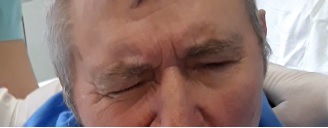Category: Dystonia: Pathophysiology, Imaging
Objective: We present a case with apraxia of eyelid opening, orbicularis oculi spasms, increased blinking, which falls within the new paradigm that defines blepharospasm, that of networking disorder.
Background: Secondary blepharospasm, focal dystonia with an involuntary contraction of the orbicularis oculi due to vascular, traumatic, toxic, or other cause of brain lesions was reported in the literature. Focal dystonia was well documented for vascular lesions in the thalamus / subthalamic region. But capsular hemorrhages with bilateral blepharospasm were very rare described weeks or months after strokes and denote the complexity of connection and circuitry between pyramidal, extrapyramidal, other motor systems that control motility and aberrant neuroplasticity.
Method: We report a 62 years retired male, alcoholic, with a history of hypertension and craniocerebral trauma, with subdural hematoma years ago, showed up at the emergency room with right hemiparesis, dysarthria and headache. Shortly after admission, he presented with focal dystonia.
Results: CT scan and MRI showed an acute hemorrhage in the internal capsule on the left side (2,8/2cm). The clinical examination reveals facies erythematous, right central facial paresis, dysarthria, right hemiplegia (0/5 MRC, for upper and lower limb), right Babinski sign. He presented apraxia of eyelid opening, orbicularis oculi spasms, increased blinking, and complained of a burning sensation and grittiness in both eyes, and dry eye too. From the first day, the patient presented bilateral blepharospasm despite the small hemorrhagic capsular stroke, that remitted soon after discharge (as we will present in the video).
Conclusion: Although blepharospasm was originally assigned to basal ganglia disorder, fIRM and neurophysiological tests demonstrate structural and functional involvement of several brain regions, including the internal capsule. In this aspect, blepharospasm should be considered as a network disorder, and this might reflect the varying occurrence of motor and nonmotor manifestations in patients with this focal dystonia.
References: –
To cite this abstract in AMA style:
MC. Posirca, R. Ivan, I. Caloianu, M. Mitrica, CA. Sirbu. Blepharospasm – a network disorder [abstract]. Mov Disord. 2021; 36 (suppl 1). https://www.mdsabstracts.org/abstract/blepharospasm-a-network-disorder/. Accessed April 30, 2025.« Back to MDS Virtual Congress 2021
MDS Abstracts - https://www.mdsabstracts.org/abstract/blepharospasm-a-network-disorder/

